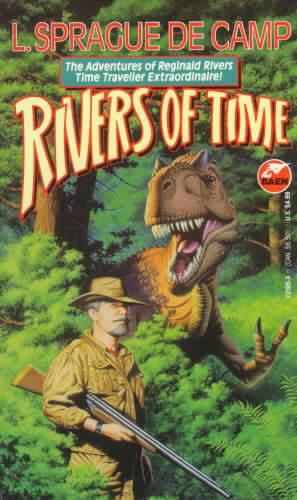7 /10 1 Votes7
Language English Media type Print (paperback) ISBN 0-671-72195-X Originally published 1993 OCLC 29138676 | 3.5/5 Goodreads Publication date 1993 Pages 258 pp LC Class MLC R CP01173 Country United States of America | |||||||||||||||||||||||||||||||||
 | ||||||||||||||||||||||||||||||||||
Genres Short story, Science Fiction, Speculative fiction Similar L Sprague de Camp books, Short Stories | ||||||||||||||||||||||||||||||||||
Book review rivers of time by l sprague de camp
Rivers of Time is a 1993 collection of short stories by science fiction and fantasy author L. Sprague de Camp, first published in paperback by Baen Books. All but two of the pieces were originally published between 1956 and 1993 in the magazines Galaxy, The Magazine of Fantasy & Science Fiction, Analog, and Asimov's Science Fiction, and the Robert Silverberg-edited anthology The Ultimate Dinosaur. The remaining pieces were first published in the present work.
Contents
- Book review rivers of time by l sprague de camp
- The series
- Rules of time travel
- Species featured
- Obsolete science
- Sequel
- References
The book collects the author's nine tales of time-traveling hunter Reginald Rivers, the hero of his 1956 classic, "A Gun for Dinosaur". He wrote another Rivers story in 1990 to fulfil a request by Robert Silverberg for a dinosaur story for his 1991 anthology The Ultimate Dinosaur; afterwards, de Camp added to the sequence until he had enough stories for a book.
Contents
The series
The Rivers stories take the form of first-person narratives by the protagonist told to companions whose identities vary, but who have in common the fact that their contributions to the conversation are omitted, and must be inferred from those of Rivers. Every story is an anecdote from Rivers' career as a conductor of time safaris to previous eras, both to hunt prehistoric creatures and for scientific purposes (and, occasionally, anti-scientific purposes). In addition to Rivers, the main recurring characters include fellow members of his safari firm, including his partner Chandra Aiyar, camp boss Beauregard Black, and cook Ming. In most instances, the actions of their human clients prove more troublesome than those of the extinct fauna, a theme set in "Faunas", a 1968 poem by de Camp that precedes the stories. An afterword by the author tells how he came to write the series.
Rules of time travel
- The effective range of the stories' time machine is from about one hundred thousand years to about one billion years in the past, with periods more recent or earlier beyond its ability to reach.
- The further back in time the machine travels the less accurate it is; beyond the Triassic, it may arrive days or even months off schedule.
- The amount of time the machine spends in another era appears to equal in length to the amount of time that elapses in the present, in its absence.
- The timestream does not appear to allow paradox, defined as anything that might significantly alter events subsequent to the period visited. For instance, a person cannot travel to the same time twice. Attempting to do results in one being thrown back to the present, "torn to shreds in the process." The same would presumably result from attempting to interact with early humans. Therefore, the time machine is restricted from visiting the period of protohuman development, and refrains from visiting any time within one thousand years of a previous visit.
Species featured
Prehistoric species of various eras featured in the series include Agriochoerus, Alamosaurus, Archaeotherium, Brontops, Camptosaurus, Columbian mammoth, Coryphodon, Deinosuchus, Diprotodon, Eurypterid, Gastornis (called Diatryma), Gorgosaurus, Hoplophoneus, Hyaenodon, Ichthyostega, Mastodon, Megalania, Merycoidodon, Metamynodon, Metoposaurus, Mylodon, Ornithomimus, Parasaurolophus, Phenacodus, Placerias, Postosuchus, Procoptodon, Rutiodon, Saurophaganax or Allosaurus (referred to as Epanterias), Stegosaurus, Teratosaurus, Triceratops, Troodon formosus (presented as Stenonychosaurus, and supposedly a type of pachycephalosaur), and Tyrannosaurus trionychus.
Tyrannosaurs of the genus Gorgosaurus are mentioned occasionally, and many times Reginald Rivers will say that the Raja is out in some period in the Cenozoic, taking a group to hunt some form of prehistoric mammal such as titanothere, entelodont, or uintathere. Prehistoric marsupials and Indricotherium are mentioned in "The Synthetic Barbarian," and numerous Pleistocene megafauna are seen in "The Mislaid Mastodon," including Castoroides ohioensis and the American lion.
Obsolete science
While Rivers of Time is a well researched time travel series, paleontological knowledge has improved since the stories were written, rendering some aspects of its portrait of the prehistoric past obsolete. Dated material includes the following:
Sequel
A tenth story of Reginald Rivers, "Gun, Not for Dinosaur", authored by Chris Bunch, appeared in Harry Turtledove's 2005 tribute anthology honoring L. Sprague de Camp, The Enchanter Completed.
